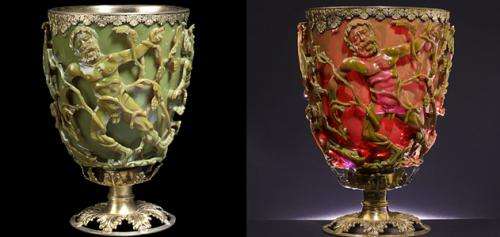August 27, 2013 weblog
Goblet tricks suggests ancient Romans were first to use nanotechnology

(Phys.org) —Recent evidence suggests that the Roman craftsmen who created the Lycurgus Cup, a glass drinking goblet, used nanotechnology to cause the goblet to change color under different lighting. The cup's unique properties were first noted when it was brought to a museum in the 1950s—it wasn't until 1990, however, that researchers figured out how the color changers were brought about.
The goblet was created approximately 1,600 years ago, using a process whereby very tiny gold and silver particles were embedded in the glass. In normal lighting, the glass appears to have a jade background. When lit from behind, however, the green parts suddenly look ruby red. This is all courtesy of the way electrons vibrate when struck by photons—something the Romans could not have known. Yet, because other goblet pieces have been found with the very same mixture, it's clear they knew they were on to something. They actually used the color changing effects to create stories. The Lycurgus Cup, for example, depicts the story of King Lycurgus as he is caught up in a tangle of grapevines—penance for treachery committed against Dionysus, the god of wine in Greek mythology.
Researchers speculate that the Romans simply ground the metal particles until it would take a thousand of them to match the size of single sand grain, then mixed them in with the hot liquid glass. But that wasn't the end of the story: the Romans created a goblet such as the Lycurgus Cup, by carving it from a single block. That means they also understood that different thicknesses of the glass would exhibit different coloring as well.
New research has suggested that the cup also changes colors when liquid is poured into it (although the researchers did not do so as it might have caused damage). Instead, they undertook lab experiments to replicate the makeup of the cup then applied various liquids. Their results suggest the cup might have displayed a variety of colors depending on which sort of beverage was poured into to it.
Researchers are just now, all these years later, learning about such color changing properties of materials with embedded nanoparticles. The hope is that these properties can be exploited to perform chemistry or medical tests cheaply and quickly by displaying different colors under different conditions.
More information: via Smithsonianmag
© 2013 Phys.org



















